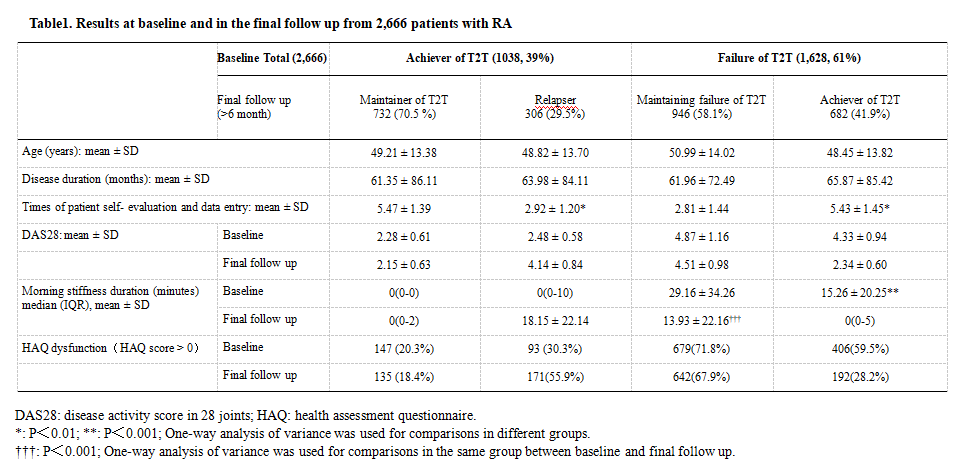Session Information
Session Type: ACR Poster Session C
Session Time: 9:00AM-11:00AM
Background/Purpose: Treat-to-Target (T2T), achieving a DAS28 score lower than 2.6 (remission, Rem) or below 3.2 (low disease activity, LDA), is the main management strategy recommended by ACR and EULAR. The Smart System of Disease Management (SSDM) is an interactive mobile disease management tool, including the doctors’ and patients’ application system. The patients can perform self-evaluation, including DAS28, morning stiffness duration (MSD) and HAQ, and input medical records (including medication and laboratory test results) through the mobile application. The data synchronizes to the mobiles of authorized rheumatologists through cloud data base and advices could be delivered. The objective of this study is to evaluate the patterns of T2T and related influential factors among RA patients after applying SSDM in real world.
Methods: Patients were registered through downloading the SSDM application, then were trained to master SSDM by health professionals in clinics. The first assessment for DAS28 were performed as baseline. The patients were required to perform repeated assessments once a month after leaving clinic.
Results: From Jun 2014 to May 2018, 2,666 RA patients from 154 hospitals across China were followed up for more than 6 months through SSDM, and the results at baseline and in final follow up were shown in table 1.The rate of T2T achievers were 39% (1,038/2,666) at baseline, and improved significantly to 53% (1,414/2,666) after 6 month follow up, p<0.05. Among T2T achievers at baseline, 70.5% (732/1,038) maintained T2T, 29.5% (306/1038) relapsed. Compared with relapsers, T2T maintainers performed more self-evaluation and data entry (5.47 vs 2.92, p<0.01). Among the pateints who maintained T2T£¬Among patients failed to reach T2T at baseline, 41.9% (682/1,628) achieved T2T after 6 months. Comparing with 6 month failure 58.1%(946/1,628), new T2T achievers got lower HAQ score (1.98 ± 2.15 vs 4.68 ± 3.52, p<0.001) at baseline, performed more times of self-evaluation and data entry (5.43 vs 2.81, p<0. 01). However, even in patients of 6 month failure, the MSD and HAQ score were improved significantly in final follow up comparing with those at baseline (13.93±22.16mins vs 29.16 ± 34.26mins, p<0.001 and 2.18 ± 2.25 vs 4.68 ± 3.52, p<0.001, respectively).
Conclusion: After proactive disease management via SSDM for more than 6 months, the rate of T2T in RA patients increased significantly. The patients who bear better HAQ scores and perform more self-evaluations through SSDM had lower probability of relapse and higher T2T maintaining and achievement. SSDM is a valuable tool for long term RA follow-up through empowering patients. Future RCT of improvingT2T outcome through intervention of above influential factors with SSDM is warranted
To cite this abstract in AMA style:
Mu R, Li C, Yang J, Wei H, Huang J, Fan W, Wang Y, Wang H, Zou J, Shi X, Xin X, Wu J, Li F, Li S, Yang H, Zhang A, Zhao D, He J, Zhang J, Li L, Ji P, Rong X, Jiang F, Wang L, Jia Y, Xiao F, Li ZG. Pattern Shift and Influential Factors in Promoting Treat-to-Target (T2T) for Follow-up RA Patients with a Rheumatologist-Patient Interactive Smart System of Disease Management (SSDM): A Cohort Study from China [abstract]. Arthritis Rheumatol. 2018; 70 (suppl 9). https://acrabstracts.org/abstract/pattern-shift-and-influential-factors-in-promoting-treat-to-target-t2t-for-follow-up-ra-patients-with-a-rheumatologist-patient-interactive-smart-system-of-disease-management-ssdm-a-coho/. Accessed .« Back to 2018 ACR/ARHP Annual Meeting
ACR Meeting Abstracts - https://acrabstracts.org/abstract/pattern-shift-and-influential-factors-in-promoting-treat-to-target-t2t-for-follow-up-ra-patients-with-a-rheumatologist-patient-interactive-smart-system-of-disease-management-ssdm-a-coho/

